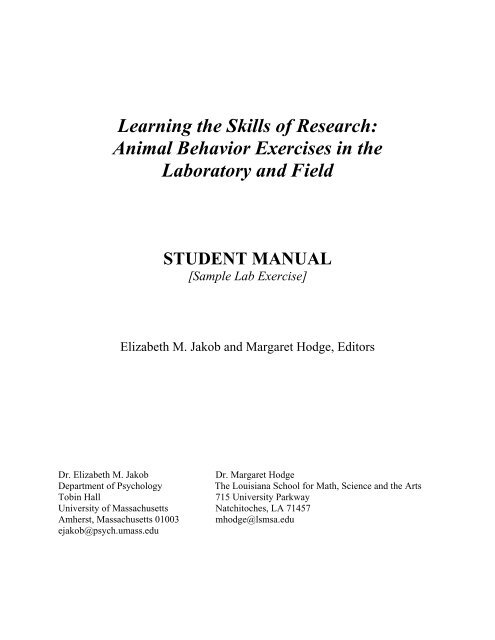Animal Behavior Lab Manual Sample
Animal Behavior Lab Manual Sample
Animal Behavior Lab Manual Sample
Create successful ePaper yourself
Turn your PDF publications into a flip-book with our unique Google optimized e-Paper software.
Learning the Skills of Research:<br />
<strong>Animal</strong> <strong>Behavior</strong> Exercises in the<br />
<strong>Lab</strong>oratory and Field<br />
STUDENT MANUAL<br />
[<strong>Sample</strong> <strong>Lab</strong> Exercise]<br />
Elizabeth M. Jakob and Margaret Hodge, Editors<br />
Dr. Elizabeth M. Jakob Dr. Margaret Hodge<br />
Department of Psychology The Louisiana School for Math, Science and the Arts<br />
Tobin Hall 715 University Parkway<br />
University of Massachusetts Natchitoches, LA 71457<br />
Amherst, Massachusetts 01003 mhodge@lsmsa.edu<br />
ejakob@psych.umass.edu
Exercise 6: The Collection of <strong>Behavior</strong>al Data<br />
Susan W. Margulis<br />
Goals<br />
1. To practice the two most common methods of behavioral data collection<br />
2. To understand the situations for which each method is most appropriate<br />
Background<br />
Now that you’ve learned the basic differences between continuous, focal sampling and<br />
instantaneous sampling, you will next have the opportunity to practice these methods. In this lab,<br />
we will provide you with two ethograms (see Exercise 5 for more detail about ethograms and<br />
how they are constructed). One is for meerkats (Suricata suricata) and the other is for whitecheeked<br />
gibbons (Hylobates concolor). Familiarize yourself with these ethograms.<br />
Methods<br />
Choose a partner to work with. Begin with the video clip of meerkats. Meerkats are a type<br />
of mongoose. They inhabit arid areas of southern Africa, and live in groups that usually consist<br />
of several families. When foraging, one member of the group can usually be found standing<br />
upright scanning the surroundings for danger. This individual is often referred to as a “sentry.”<br />
You will be doing an instantaneous, scan sample of the animals in this group. Carefully<br />
review the ethogram and data sheet.<br />
The camera will pan (or “scan”) across the group. Watch the tape at least once before you<br />
begin your observation.<br />
On your data sheet, tally up how many animals you see engaged in each behavior. Note<br />
that you may not always see the same number of animals, as they may run in or out of the range<br />
of the camera. You and your partner may alternate roles of observer (watching the tape and<br />
calling out what each animal is doing) and recorder (writing the tally marks on the sheet).<br />
Next, move on to the video clip of gibbons. White-cheeked gibbons are lesser apes from<br />
southeast Asia. They live in small family groups. Both mother and father care for the offspring.<br />
Females are blonde, and males are black. All infants are born with blonde hair, which turns black<br />
at about a year of age. Males retain their black hair, while females’ hair becomes blonde again as<br />
they approach maturity. The group you will observe consists of a mother and father, and their<br />
year-old son.<br />
You will be doing a continuous, focal observation of the infant gibbon. Carefully review<br />
the ethogram and data sheet. Watch the tape at least once before you begin your observation.<br />
Use the timer in the upper left corner of the screen to note on your data sheet the time at<br />
which a behavior state changes, or an event occurs. Check the appropriate behavior column.<br />
Your first entry should always be at time 0:00 (0 minutes and 0 seconds). For those behaviors<br />
that involve more than one animal (the focal subject plus another animal) be sure to indicate on<br />
your data sheet which animals are involved and who initiates a behavior. For example, “mom<br />
touches baby” is not the same as “baby touches mom.” Be consistent in your use of<br />
abbreviations. You may use “m” for mother, “f” for father, and “b” for baby. You may work<br />
with your partner or each do an independent observation, and compare your results.
Now look at the sample data on your handout. Compare your observations to the researcher<br />
sample. Open the “mock data” table, and use these data to calculate the percent agreement<br />
between two observers, following the instructions in the table legend.<br />
Questions<br />
In your write-up, include copies of your data sheets, and those of your partner or a member<br />
of another group. Please address the following points:<br />
1. The similarity between observers is called interobserver reliability. How similar were your<br />
observations to another student’s observations? How similar were they to the “researcher<br />
sample” observations?<br />
2. How do you explain any observed differences? Why is it important to minimize these? What<br />
could you do to maximize interobserver reliability?<br />
3. Do you think it is possible to eliminate all interobserver variation? Elaborate.<br />
4. What was the percent agreement calculated from the mock data?<br />
5. What sort of questions about meerkat behavior could be addressed with the type of data that<br />
you collected? What about the gibbons?<br />
Acknowledgments<br />
Video footage was provided by Brookfield Zoo (© 2000 Chicago Zoological Society), and<br />
was filmed by Howard Greenblatt. The data sheets were developed in collaboration with the<br />
Center for Learning Technologies in Urban Schools, with partial funding by NSF grant DGE-<br />
9809636.<br />
Further reading<br />
Altmann, J. 1974. Observational study of behavior: sampling methods. Behaviour 49: 227–265.<br />
Lehner, P. N. 1996. Handbook of Ethological Methods. (2nd edition). Cambridge University<br />
Press, NY.<br />
Martin, P. and Basteson, P. 1993. Measuring <strong>Behavior</strong>: An Introductory Guide. (2nd edition.<br />
Cambridge University Press, New York.
Methods<br />
SCAN SAMPLING—Meerkats<br />
Use scan (instantaneous) sampling to record the behavior of all meerkats that you see at<br />
30-second intervals for 3 minutes. Using the ethogram provided below, enter on your data sheet<br />
the number of individuals in each behavior category on each scan. Always begin your scan when<br />
the stopwatch beeps. Always start your scan at the same location. You may work in pairs, with<br />
one member serving as the “recorder” and one the “observer.” Switch roles mid-way through.<br />
Ethogram<br />
States (for definition, see Exercise 5)<br />
Forage: <strong>Animal</strong> consumes or manipulates food or digs in the dirt in search of food.<br />
Rest: <strong>Animal</strong> sits or lies immobile, eyes open or closed, not doing anything else.<br />
Play: <strong>Animal</strong>s engage in rough and tumble social interaction or chasing.<br />
Sentry: <strong>Animal</strong> stands upright on hind legs, alert, looking at surroundings.<br />
Locomote (LOC): <strong>Animal</strong> runs, walks, or climbs around exhibit.<br />
Social Groom (SOC.GM): <strong>Animal</strong> uses its teeth or front paws to comb through<br />
another animal’s fur.<br />
Other: Any other behavior not listed above.
FOCAL SAMPLING—White-Cheeked Gibbon<br />
Methods<br />
Use continuous focal animal sampling to record the behavior of the baby white-cheeked<br />
gibbon. Using the ethogram provided below, observe the youngster for 3 minutes. Whenever he<br />
changes his behavioral state, write down the time (minutes and seconds) and check the<br />
appropriate behavior column. Whenever he performs an event, write the time and mark in the<br />
column who is involved in the behavior: (M)other, (F)ather, (B)aby. For example, if the Father<br />
bites the Baby, write “FB” in the BITE/HIT column.<br />
Ethogram<br />
States (for definition, see Exercise 5)<br />
Rest: <strong>Animal</strong> sits, stands, or lies; immobile; no other activity. Eyes open.<br />
Locomotion/ Explore (LOC): Any movement by the animal, on the ground, rocks,<br />
or in trees.<br />
Forage: <strong>Animal</strong>s searches for, manipulates, or consumes food or water.<br />
Groom: One animal runs its fingers or teeth through the fur of another.<br />
Play: Manipulation of objects or apparently purposeless movement. May involve<br />
another animal. Note who is involved and describe the play.<br />
On Mom: Infant clings to fur of mother.<br />
Other: Any behavior not listed above.<br />
Out of View (OOV): <strong>Animal</strong> is not visible.<br />
Events (For definition, see Exercise 5)<br />
Touch: One animal puts hand on the arm, head, or other body part of another animal.<br />
Gesture is gentle and friendly, not aggressive.<br />
Bite/Hit: Aggressive, hard, rapid touch or push, or placing mouth on another animal and closing<br />
with apparent force.
Scan<br />
1<br />
2<br />
3<br />
4<br />
5<br />
6<br />
7<br />
Sentry<br />
Meerkat Scan Data Sheet (see Excel file)<br />
Forage<br />
Locomote<br />
Date _______________ Time _______________ Observer _______________<br />
Rest<br />
Play<br />
Soc.Groom<br />
Other<br />
Comments
Time<br />
0:00<br />
Rest<br />
Gibbon Focal Data Sheet (see Excel file)<br />
Locomotion<br />
Forage<br />
STATES EVENTS<br />
Groom<br />
Date _______________ Time _______________ Observer _______________<br />
Play<br />
On Mom<br />
Other<br />
OOV<br />
Touch<br />
Bite/Hit<br />
Comments





